SIU Director’s Report - Case # 17-OVI-018
Warning:
This page contains graphic content that can shock, offend and upset.
Contents:
Mandate of the SIU
The Special Investigations Unit is a civilian law enforcement agency that investigates incidents involving police officers where there has been death, serious injury or allegations of sexual assault. The Unit’s jurisdiction covers more than 50 municipal, regional and provincial police services across Ontario.
Under the Police Services Act, the Director of the SIU must determine based on the evidence gathered in an investigation whether an officer has committed a criminal offence in connection with the incident under investigation. If, after an investigation, there are reasonable grounds to believe that an offence was committed, the Director has the authority to lay a criminal charge against the officer. Alternatively, in all cases where no reasonable grounds exist, the Director does not lay criminal charges but files a report with the Attorney General communicating the results of an investigation.
Information restrictions
Freedom of Information and Protection of Personal Privacy Act (“FIPPAâ€)
Pursuant to section 14 of FIPPA (i.e., law enforcement), certain information may not be included in this report. This information may include, but is not limited to, the following:
- Confidential investigative techniques and procedures used by law enforcement agencies; and
- Information whose release could reasonably be expected to interfere with a law enforcement matter or an investigation undertaken with a view to a law enforcement proceeding.
Pursuant to section 21 of FIPPA (i.e., personal privacy), protected personal information is not included in this document. This information may include, but is not limited to, the following:
- subject officer name(s)
- witness officer name(s)
- civilian witness name(s)
- location information
- witness statements and evidence gathered in the course of the investigation provided to the SIU in confidence and
- other identifiers which are likely to reveal personal information about individuals involved in the investigation
Personal Health Information Protection Act, 2004 (“PHIPAâ€)
Pursuant to PHIPA, any information related to the personal health of identifiable individuals is not included.
Other proceedings, processes, and investigations
Information may have also been excluded from this report because its release could undermine the integrity of other proceedings involving the same incident, such as criminal proceedings, coroner’s inquests, other public proceedings and/or other law enforcement investigations.
Mandate engaged
The Unit’s investigative jurisdiction is limited to those incidents where there is a serious injury (including sexual assault allegations) or death in cases involving the police.
“Serious injuries†shall include those that are likely to interfere with the health or comfort of the victim and are more than merely transient or trifling in nature and will include serious injury resulting from sexual assault. “Serious Injury†shall initially be presumed when the victim is admitted to hospital, suffers a fracture to a limb, rib or vertebrae or to the skull, suffers burns to a major portion of the body or loses any portion of the body or suffers loss of vision or hearing, or alleges sexual assault. Where a prolonged delay is likely before the seriousness of the injury can be assessed, the Unit should be notified so that it can monitor the situation and decide on the extent of its involvement.
This report relates to the SIU’s investigation into the serious injury sustained by a 27-year-old man when he was struck by a stolen motor vehicle on January 18, 2017.
The investigation
Notification of the SIU
On January 18, 2017, at 11:50 a.m., the Waterloo Regional Police Service (WRPS) notified the SIU of a vehicle injury that occurred that morning.
WRPS reported that at 10:56 a.m. that morning, the Subject Officer (SO) spotted a stolen vehicle on Spadina Road in Kitchener. He attempted to stop the vehicle but the driver fled. The SO pursued the vehicle to Queen’s Boulevard at Belmont Avenue where the pursued vehicle collided with several other vehicles. In total, six vehicles were involved.
A pedestrian was struck in the collision and sustained significant injuries. Two occupants of another vehicle were also injured. All injured persons were taken to the hospital while the driver of the stolen vehicle fled on foot.
The civilian witnesses were placed onto a Grand River Transit (GRT) bus at the scene.
The team
Number of SIU Investigators assigned: 11
Number of SIU Forensic Investigators assigned: 2
Number of SIU Collision Reconstructionists assigned: 2
SIU Forensic Investigators responded to the scene and identified and preserved evidence. They documented the relevant scene associated with the incident by way of notes, photography, videography, sketches and measurements.
Complainant
27-year-old male interviewed, medical records obtained and reviewed
Civilian Witnesses
CWÂ #1 Interviewed
CWÂ #2 Interviewed
CWÂ #3 Interviewed
CWÂ #4 Interviewed
CWÂ #5 Interviewed
CWÂ #6 Interviewed
CWÂ #7 Interviewed
CWÂ #8 Interviewed
CWÂ #9 Interviewed
CWÂ #10 Interviewed
CWÂ #11 Interviewed
CWÂ #12 Interviewed
CWÂ #13 Interviewed
CWÂ #14 Interviewed
Witness Officers
WOÂ #1 Interviewed
WOÂ #2 Interviewed
WOÂ #3 Interviewed
WOÂ #4 Interviewed
WOÂ #5 Interviewed
WOÂ #6 Interviewed
Additionally, the notes from one other, non-designated officer were received and reviewed.
Subject Officers
SO Interviewed, but declined to submit notes, as is the subject officer’s legal right.
Incident narrative
During the late morning of January 18, 2017, the SO was operating a fully marked cruiser parked on South Drive, near Queen’s Boulevard, in Kitchener. He was working with WO #2 and WO #3, who were positioned nearby in an unmarked minivan, conducting surveillance.
While the SO was parked, CW #14 drove by in a black Toyota FJ Cruiser that was towing a camping trailer. The SO queried the vehicle’s licence plate and received a response indicating that the vehicle was stolen. The SO turned his cruiser around and followed the stolen Toyota FJ Cruiser (the SUV). The SUV turned right onto Highland Road and accelerated to about 80 km/h toward the intersection at Spadina Road. The light was green for Highland Road traffic and the SUV slowed, appearing to prepare to turn left onto Spadina Road. The SO pulled up immediately behind the SUV, but the SUV made an abrupt right turn from the left turn lane, cutting off a vehicle in the through lane to its right.
The SO activated the emergency lighting and siren and approached the intersection, but by the time the SO had turned to follow, the SUV was some distance away. He deactivated the siren and kept the emergency lighting activated. The SO drove on Glen Road with the SUV about 200 metres ahead of him and accelerating away. When the SO arrived at the end of Glen Road, at the intersection with South Drive, he stopped and did not see the SUV in either direction. The SO was 200 to 300 metres from Queen’s Boulevard when the intersection came into view and he saw the SUV skidding and sliding sideways to a stop.
The Complainant was crossing Belmont Avenue at Queen’s Boulevard on foot and was almost half way across the intersection when the SUV drove through a red light at the intersection, turning right from Queen’s Boulevard onto Belmont Avenue. The SUV swerved in an attempt to avoid the Complainant and struck another car in the intersection, as well as the Complainant, sending him into the air. The SUV hit two other vehicles before coming to a stop. CW #14 exited the SUV and fled the scene on foot.
Several people, including the Complainant, were taken to hospital by ambulance. The Complainant sustained a fractured skull and compound fractures to his left tibia and fibula.
Evidence
The scene
The following Google Map image highlights the route taken by CWÂ #14 and the SO:
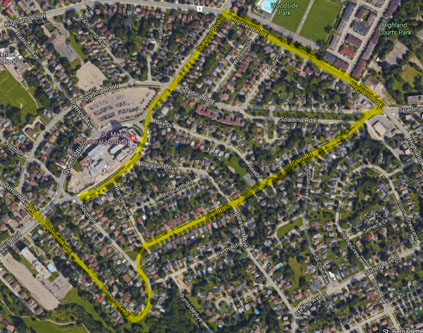
Belmont Avenue is divided into Belmont Avenue West on the west side of the intersection with Queen’s Boulevard and Belmont Avenue East on the east side.
The investigation revealed an area where the trailer lost traction and slid to the left, striking the snow bank in front of a residence on Belmont Avenue East. This area is at the end of the 180° turn with a yellow posted speed limit advisory sign of 10 km/h and is where CW #12 found the SUV’s licence plate.
Other than the 10Â km/h advisory speed limit sign, there were no posted speed limit signs along the route. The speed limit is 50Â km/h unless otherwise posted.
The route travelled was mostly residential with commercial properties around the intersection of Highland Road East and Spadina Road East.
The scene examination revealed that the initial area of impact occurred in the westbound lane of Belmont Avenue West and the southbound lane of Queen’s Boulevard. A Silver Hyundai was southbound on Queen’s Boulevard and entered the intersection, while the stolen SUV was westbound on Belmont Avenue. The front of the Hyundai collided with the right side of the stolen SUV.
CWÂ #1 stopped her Toyota Matrix behind the Hyundai and was not involved in the collision.
The collision redirected the stolen SUV to the left, where it collided with the Complainant, before continuing and colliding with a Mazda 3 and a Honda CR-V that were eastbound on Belmont Avenue West.
The stolen SUV continued west, appearing to have been out of control by this time, as the trailer broke apart, scattering parts and contents throughout the area.
A Toyota Tacoma pick-up truck at the scene was not involved in the collision.
The SUV came to rest across Belmont Avenue West on the east side of the intersection with Spadina Road West. Only the metal frame of the trailer remained intact and attached to the truck.
Below are two overhead photos taken of the scene:
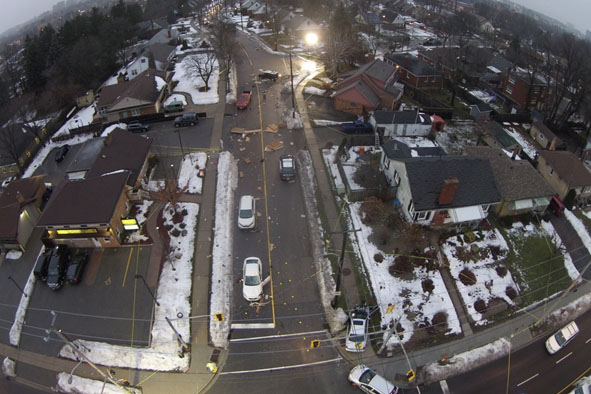
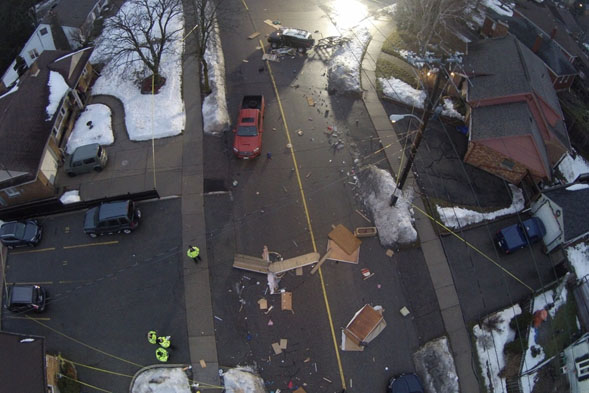
Below are several photos of the damage caused:
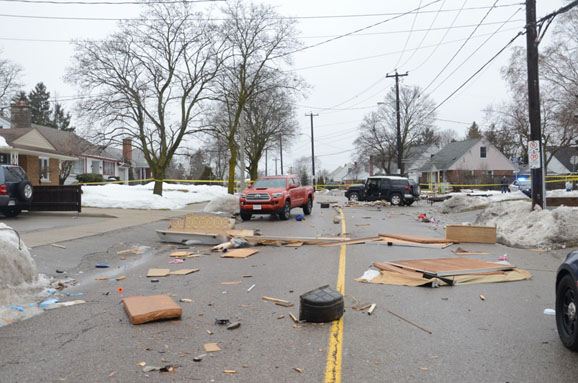
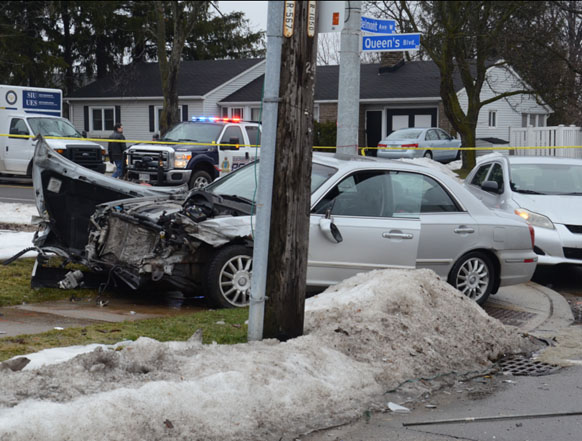
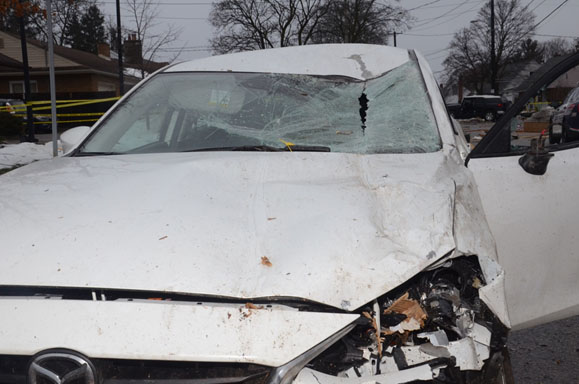
Scene diagram
The following drawing depicts the collision scene and debris field:
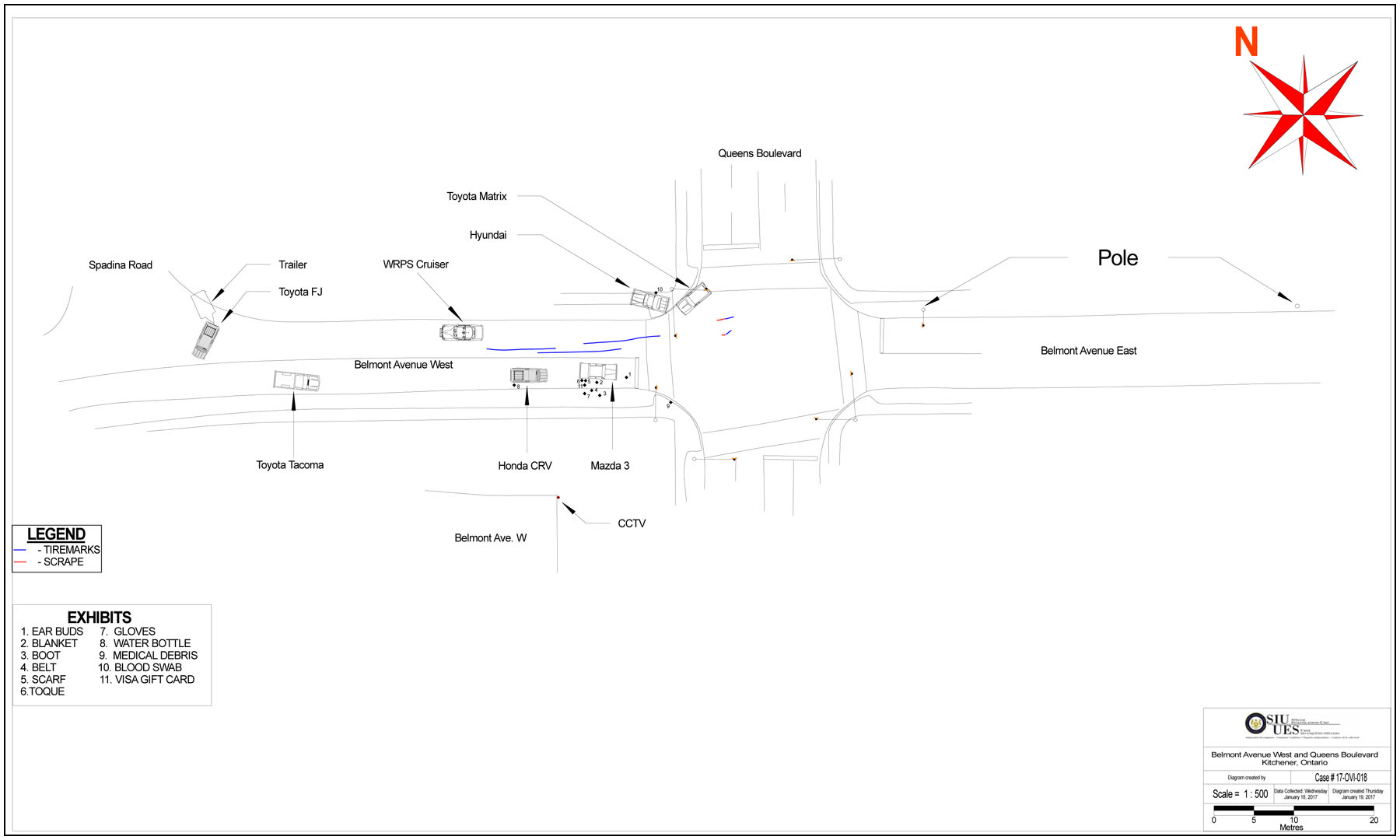
Physical evidence
SO’s Cruiser:
The SO’s cruiser was examined at the scene. The emergency lights and siren were observed in proper working order.
Forensic Evidence
Automated Vehicle Locator (AVL) Data and the Route:
The AVL data from the SO’s cruiser recorded the route, speeds and times in this incident.
The data revealed that the SO started following the stolen SUV at South Drive near Queen’s Boulevard. He turned right and drove northeast on Queen’s Boulevard, passing a pedestrian crosswalk at the northwest side of St. Mary’s General Hospital, near the intersection with Rex Drive. He drove about 0.6 km on Queen’s Boulevard to the traffic light controlled intersection at Highland Road East, reaching a speed of 59 km/h, before slowing at Highland Road.
The SO turned right onto Highland Road and accelerated to 82Â km/h over about 0.4Â km before slowing at the traffic light controlled intersection with Spadina Road East. At Spadina Road East, he turned right but accessed Glen Road at this unusual juncture. He quickly accelerated to 90Â km/h over about 0.7Â km before slowing at the stop sign at South Drive.
The intersection of Glen Road and South Drive is about 0.2Â km southeast of where the SO initially started following the stolen SUV.
The SO turned left onto South Drive and drove a short distance to the stop sign at Perth Road. He continued on South Drive as the road turned 180° to the right. Through this bend, the advised speed limit is posted at 10 km/h. After the turn, the road changed to Belmont Avenue East and continued in a northwest alignment.
On Belmont Avenue, the SO accelerated to 94 km/h before slowing to 67, 33 and then 14 km/h about 0.3 km later. He crossed Queen’s Boulevard and arrived at the collision scene.
The entire route was measured to be about 2.3Â km.
Video/Audio/Photographic Evidence
The SIU canvassed the area for any video or audio recordings, and for photographic evidence, and received photos taken by CWÂ #7 and CWÂ #9, as well as closed circuit television (CCTV) videos from a nearby business and gas station.
Gas Station CCTV Video Recording
The gas station at the southwest corner of Highland and Spadina Roads had a surveillance camera mounted with a view of the intersection.
The stolen SUV entered view at 10:54:44 on the recording. The truck was in the left lane of Highland Road, which had pavement markings as a left turn lane. There is one through lane to the right of this lane. The traffic control signal was green for Highland Road traffic and there were two vehicles in front of the truck. As the SUV slowed, the SO’s cruiser appeared directly behind it and in the through lane to the right of the SUV.
The SUV slowed and, with no indicating signal, abruptly turned right, crossing the through lane to the right, cutting off a commercial minivan in the process. It continued to the right turn lane and onto Spadina Road.
The cruiser’s emergency lights activated as the SUV turned. The cruiser moved to the left turn lane and drove into the intersection. Although the view was obstructed by the gas pumps, signage, and the commercial minivan, it appeared that the cruiser came to a stop beside the minivan before turning right. The cruiser then turned right to the left of the concrete median separating oncoming traffic on Spadina Road, driving into the oncoming lane. The cruiser drove off in the same direction as the SUV, about eight seconds later.
Nearby Business CCTV Video Recording
The business situated at the southwest corner of Belmont Avenue West and Queen’s Boulevard had a surveillance camera which was aligned with a view of a portion of the intersection.
The recording captured images of a person, now known to be the Complainant, walking north on the west sidewalk of Queen’s Boulevard. He stopped at the corner for the red light, before stepping onto the roadway when the light permitted him to cross to the north side of Belmont Avenue West. He disappeared from the camera view as he crossed the road.
Shortly thereafter, at 11:36:58Â a.m.[1] on the recording, the stolen SUV towing a trailer appeared driving west on Belmont Avenue at what appeared to be a high rate of speed. It appeared the truck drove through the intersection against a red light.
At 11:37:15 a.m. on the recording, 17 seconds after the SUV drove through the intersection, a marked WRPS cruiser appeared and drove through the intersection at a much slower speed with emergency lighting activated.
Communications Recordings
Radio Transmission Recordings
The SO’s initial transmission was on the Community Oriented Response and Enforcement (CORE) team’s special channel. He asked WO #2 and WO #3 where they were and said he “had a stolen FJ Cruiser come by me.†He said that the vehicle was in front of him at “Queen and Spadina†and asked if they could attend. WO #3 responded that they were en route.
The SO then reported that he did not think the driver of the truck was aware that the police were behind him. WO #3 or WO #2 asked the SO to “try and stay as far as you can from it until can get behind it and we’ll get patrol involved.†The SO responded that the truck was “…at a disadvantage right now. It’s got a trailer attached to it at the back right now†and that he did not see how many occupants were in the vehicle. The SO then reported that the truck was on Highland Road and he believed the driver became aware of the police presence as the SUV’s speed increased. The SO said he was driving at “roughly 80 right now†and he was going to call it in on the central channel.
In the next transmission he said they were on Spadina Road, heading toward the hospital. WOÂ #2 and WOÂ #3 said that was where they were.[2]
In the initial transmission on the central channel, the SO said that he was at South Drive when he reported, “I’m in pursuit of a vehicle reported stolen†and provided the licence plate. With the cruiser engine revving in the background, the SO then reported, “It bailed. It bailed.†and said he was at Spadina and Queen’s Boulevard.
Another police officer then inquired whether the suspects fled.
The SO responded, “Yea. Hold on a second. I’m coming up to it right now. There’s like an accident. Looks like three or four MVC [motor vehicle] collisions.â€
More police officers were heard responding to the collision.
The SO sounded to be in a foot pursuit as he reported that a suspect went into a backyard on Spadina Road. In a subsequent transmission he reported that someone was injured at the scene.
911 Calls
In one of numerous 911 calls reporting the collision, an unidentified male said a Jeep “that was going pretty fast… ran a stop light and it banged into two or three cars.â€
Materials obtained from Police Service
Upon request the SIU obtained and reviewed the following materials and documents from the WRPS:
- Communications recordings
- Video and stills taken by WRPS’ unmanned aerial vehicle (UAV)
- WRPS scene photos
- Certificate of Suspect Apprehension Pursuit (SAP) Training – the SO
- Court Docket re: CWÂ #14
- Disclosure Log - Jan 19, 2017
- Dispatch from Computer Aided Dispatch (CAD) Details - Collision Incidents
- Dispatch from CAD Details - Pursuit
- Duty Roster - Jan 18, 2017-Canine
- Duty Roster - Jan 18, 2017-CORE
- Duty Roster - Jan 18, 2017-Patrol
- Email regarding list of charges for CWÂ #14
- Event Chronologies
- General Occurrence Report - Theft of Trailer
- Global Positioning System (GPS) Data – SO’s Vehicle
- Notes of WOÂ #1, WOÂ #2, WOÂ #3, WOÂ #4, WOÂ #5 and WOÂ #6
- Notes of a non-designated officer
- Occurrence Details
- Procedure - Suspect Apprehension Pursuits
- WRPS Disclosure Logs, and
- Witness Statements – CW #2, CW #3, CW #4, CW #5 and CW #6
Relevant legislation
Sections 1-3, Ontario Regulation 266/10, Ontario Police Services Act – Suspect Apprehension Pursuits
1. (1) For the purposes of this Regulation, a suspect apprehension pursuit occurs when a police officer attempts to direct the driver of a motor vehicle to stop, the driver refuses to obey the officer and the officer pursues in a motor vehicle for the purpose of stopping the fleeing motor vehicle or identifying the fleeing motor vehicle or an individual in the fleeing motor vehicle.
(2) A suspect apprehension pursuit is discontinued when police officers are no longer pursuing a fleeing motor vehicle for the purpose of stopping the fleeing motor vehicle or identifying the fleeing motor vehicle or an individual in the fleeing motor vehicle.
2. (1) A police officer may pursue, or continue to pursue, a fleeing motor vehicle that fails to stop,
- if the police officer has reason to believe that a criminal offence has been committed or is about to be committed; or
- for the purposes of motor vehicle identification or the identification of an individual in the vehicle
(2) Before initiating a suspect apprehension pursuit, a police officer shall determine that there are no alternatives available as set out in the written procedures of,
- the police force of the officer established under subsection 6 (1), if the officer is a member of an Ontario police force as defined in the Interprovincial Policing Act, 2009
- a police force whose local commander was notified of the appointment of the officer under subsection 6 (1) of the Interprovincial Policing Act, 2009, if the officer was appointed under Part II of that Act; or
- the local police force of the local commander who appointed the officer under subsection 15 (1) of the Interprovincial Policing Act, 2009, if the officer was appointed under Part III of that Act
(3) A police officer shall, before initiating a suspect apprehension pursuit, determine whether in order to protect public safety the immediate need to apprehend an individual in the fleeing motor vehicle or the need to identify the fleeing motor vehicle or an individual in the fleeing motor vehicle outweighs the risk to public safety that may result from the pursuit.
(4) During a suspect apprehension pursuit, a police officer shall continually reassess the determination made under subsection (3) and shall discontinue the pursuit when the risk to public safety that may result from the pursuit outweighs the risk to public safety that may result if an individual in the fleeing motor vehicle is not immediately apprehended or if the fleeing motor vehicle or an individual in the fleeing motor vehicle is not identified.
(5) No police officer shall initiate a suspect apprehension pursuit for a non-criminal offence if the identity of an individual in the fleeing motor vehicle is known.
(6) A police officer engaging in a suspect apprehension pursuit for a non-criminal offence shall discontinue the pursuit once the fleeing motor vehicle or an individual in the fleeing motor vehicle is identified.
3. (1) A police officer shall notify a dispatcher when the officer initiates a suspect apprehension pursuit.
(2) The dispatcher shall notify a communications supervisor or road supervisor, if a supervisor is available, that a suspect apprehension pursuit has been initiated.
Section 249, Criminal Code - Dangerous operation of motor vehicles, vessels and aircraft
(1) Every one commits an offence who operates
- a motor vehicle in a manner that is dangerous to the public, having regard to all the circumstances, including the nature, condition and use of the place at which the motor vehicle is being operated and the amount of traffic that at the time is or might reasonably be expected to be at that place…
(3) Every one who commits an offence under subsection (1) and thereby causes bodily harm to any other person is guilty of an indictable offence and liable to imprisonment for a term not exceeding ten years.
Section 322(1), Criminal Code – Theft
322Â (1) Every one commits theft who fraudulently and without colour of right takes, or fraudulently and without colour of right converts to his use or to the use of another person, anything, whether animate or inanimate, with intent
- to deprive, temporarily or absolutely, the owner of it, or a person who has a special property or interest in it, of the thing or of his property or interest in it
- to pledge it or deposit it as security
- to part with it under a condition with respect to its return that the person who parts with it may be unable to perform; or
- to deal with it in such a manner that it cannot be restored in the condition in which it was at the time it was taken or converted
Section 354(1), Criminal Code - Possession of property obtained by crime
354 (1) Every one commits an offence who has in his possession any property or thing or any proceeds of any property or thing knowing that all or part of the property or thing or of the proceeds was obtained by or derived directly or indirectly from
- the commission in Canada of an offence punishable by indictment; or
- an act or omission anywhere that, if it had occurred in Canada, would have constituted an offence punishable by indictment
Analysis and director’s decision
On January 18th, 2017, the SO was operating a marked police cruiser as part of the Community Oriented Response and Enforcement (CORE) Team. His role was to provide assistance in the event that a marked cruiser was needed to effect an arrest; his colleagues, WO #2 and WO #3, were conducting surveillance in an unmarked minivan, while he was parked nearby in the area of South Drive near Queen’s Boulevard in the City of Kitchener. While parked at this location, the SO observed a black Toyota FJ Cruiser SUV towing a camping trailer and he queried the licence plate and received a response that the vehicle was stolen. The SO turned around to follow the vehicle and observed it stopped at a red traffic light at Highland Road; there were several vehicles stopped between the Toyota and his cruiser. The SO then radioed WO #2 and WO #3 on the CORE special channel and advised them that he was following a stolen motor vehicle and believed that the driver was unaware of his presence and asked them to come to his location; this is confirmed by the radio communication recording. The SO advised that his intent was to coordinate with WO #2 and WO #3, allowing them to follow the stolen vehicle in their unmarked van, so that he could remove himself and thereby avoid a pursuit. WO #2 and WO #3 could then follow the vehicle, without the driver being aware that he was being followed by police, to its final destination and effect an arrest. The AVL data from the SO’s cruiser confirmed that his speed as he was travelling behind the SUV on Queen’s Boulevard approaching the intersection of Highland Road reached 59 km/h before the cruiser slowed at the intersection.
The SO observed the stolen vehicle turn right onto Highland Road and he followed from approximately 100 metres back. The SO is heard on the radio communication recording advising that the SUV had now begun to speed up and that they were in the area of Highland and Winslow and their speed was roughly 80 km/h; at that point, the SO advised that he would be contacting “Central†and he switched from the CORE channel to the central channel. The AVL data confirms that once on Highland Road East, the SO’s speed reached 82 km/h before slowing at the intersection with Spadina Road East.
The SUV then accelerated to approximately 80Â km/h and entered the intersection at Spadina on a green light and slowed. The SO pulled up directly behind the SUV, who he believed was waiting to turn left, when it suddenly made an abrupt right turn from the left turn lane thereby cutting off a vehicle which was in the through lane to the right of the SUV. Once the SUV made this maneuver, the SO indicated that he believed that the driver was now aware of the police presence and he activated his emergency lighting and siren and approached the intersection, first making eye contact with the driver of the vehicle to his right, to ensure that the driver was aware that he would be turning right across his path, before pursuing the SUV on Spadina Road East. This evidence is confirmed by the CCTV footage from the gas station at the corner of the intersection of Highland Road East and Spadina Road East.
The SO advised that by the time he completed his turn safely. The SUV was some distance away and he deactivated his siren, but kept his emergency roof lighting on.
The SO radioed his location as being on Spadina Road heading towards the hospital to WOÂ #2 and WOÂ #3, who advised that they were at that same location; at that point, the SO discovered that when the road split into Glen Road on the left and Spadina Road on the right, he had actually turned onto Glen Road, while he had mistakenly communicated that he was on Spadina Road.
The SO, realizing his error with respect to the location he had communicated, as a result of which he would not be meeting up with WO #2 and WO #3, contacted the dispatcher and advised that he was in pursuit of a stolen motor vehicle and provided the licence plate number and location of the vehicle as being in the area of South Drive approaching Perth. The communication recording confirmed that this call came in at 10:53:47 a.m.; there was a second transmission at 10:53:56 a.m. in which the SO advised that the vehicle had “bailed†and that he was no longer in pursuit. The AVL data confirmed that the SO accelerated to 90 km/h on Glen Road before slowing at the stop sign at South Drive.
The SO advised that he lost sight of the SUV and, believing that it may have turned left, he also turned left onto South Road. As the SO drove through the right hairpin curve, he was 200 to 300 metres from Queen’s Boulevard on Belmont Avenue East when the intersection came into view and he observed the SUV skidding and sliding sideways to a stop.
CW #6 was walking on the sidewalk on Belmont Avenue in the area of the hairpin curve, about halfway between South Drive and Queen’s Boulevard, when he heard the SUV’s tires, turned, and saw the SUV accelerate past him toward Queen’s Boulevard, where it entered the intersection against a red traffic signal and collided with other vehicles. Just after the collision, CW #6 observed a WRPS cruiser following the SUV. CW #12 located the licence plate of the stolen SUV in the snowbank.
Seven civilian witnesses were either involved, or witness to, the collision between the stolen SUV operated by CWÂ #14 and the other vehicles and the Complainant. Of those seven witnesses, none observed the WRPS cruiser at the time that CWÂ #14 sped into the intersection against the red light causing the collision. The estimates of various witnesses ranged from five seconds to two minutes, between the time of the collision and the arrival of the SO. The CCTV footage in front of a nearby business confirmed that the SO arrived in his cruiser 17Â seconds after the stolen SUV.
It is clear on all of the evidence, that at the time that the SO first observed the SUV being driven by CW #14 and received information that the motor vehicle was stolen, the SO was lawfully entitled to stop and investigate the driver of the motor vehicle for an offence of “theft†and/or “possession of stolen property†contrary to the Criminal Code.
I note that the evidence of the SO is fully confirmed by the seven civilian witnesses who were at the collision scene at the time of impact, as well as the two civilian witnesses who observed CW #14’s driving prior to the collision scene, the communications recordings, the CCTV footage, and the AVL data from the SO’s cruiser, all of which fully substantiate the fact that the SO was not in a vehicular pursuit at the time of the motor vehicle collision in which the Complainant was injured, nor had he been in pursuit immediately prior to the collision, having abandoned his efforts to apprehend the stolen SUV shortly after he initially activated his emergency equipment and attempted to stop the motor vehicle. On all of the evidence, it is clear that although the SO initially attempted to bring the SUV to a stop, which he was lawfully entitled to do, at no time did he pursue CW #14 after the SUV sped off on Glen Road after going through the intersection at Spadina and turning right; rather, the SO de-activated his siren and contacted the dispatcher to advise that the SUV had bailed and he was no longer in pursuit. This evidence is confirmed by CW #14 himself, and the evidence of the civilian witnesses who observed CW #14 at various points on his route and who all advised that the police cruiser was some distance behind the SUV and was not in sight at the time that they observed the SUV. This evidence is conclusively confirmed by the CCTV footage which revealed that the SO did not arrive at the collision site until 17 seconds after CW #14. As such, I can find no causal connection between the driving of the SO and the injuries sustained by the persons involved in the collision, which are solely attributable to the reckless and dangerous driving of CW #14.
It is worthy of note that the SO fully complied with Ontario Regulation 266/10 of the Ontario Police Services Act entitled Suspect Apprehension Pursuits, in that: he contacted an unmarked cruiser in order to facilitate strategic following and avoid a police pursuit; immediately upon realizing that the vehicle was not going to stop, he contacted the dispatcher and advised that he was in a vehicle pursuit; he provided his location and the description and licence plate of the vehicle and continued to update the dispatcher with events as they occurred; within seconds of attempting a traffic stop of the SUV, he lost sight of the vehicle as he gave priority to public safety over pursuing the stolen vehicle; and he abandoned his efforts and deactivated his siren while continuing to search for the stolen vehicle. It can be inferred on this evidence that the SO considered whether, in order to protect public safety, the immediate need to apprehend an individual in the fleeing motor vehicle outweighed the risk to public safety that may result from the pursuit, pursuant to s.2(3) of the legislation, and determined that it did not.
The final question to be determined is whether or not there are reasonable grounds to believe that the SO, in his attempt to stop CWÂ #14, committed a criminal offence, specifically, whether or not his driving rose to the level of being dangerous and therefore in contravention of s.249(1) of the Criminal Code.
The decision of the Supreme Court of Canada in R. v. Beatty, [2008] 1 S.C.R. 49, sets out the law with respect to s.249 in that it requires that “the driving be dangerous to the public, having regard to all of the circumstances, including the nature, condition and use of the place at which the motor vehicle is being operated and the amount of traffic that, at the time, is or might reasonably be expected to be at that place†and the driving must be such that it amounts to “a marked departure from the standard of care that a reasonable person would observe in the accused’s circumstancesâ€.
On a review of all of the evidence, I find that there is no evidence that the driving of the SO created a danger to other users of the roadway or that at any time did he interfere with other traffic; he used his emergency equipment prudently, initially activating both his emergency roof lighting system and his siren but then immediately deactivating his siren when he determined that CWÂ #14 was not going to stop, and the environmental conditions were good and the roads were dry.
Furthermore, the evidence establishes that the SO did nothing to exacerbate CW #14’s pattern of dangerous driving; on the evidence all of the civilian witnesses along CW #14’s route, CW #14 was driving at excessive rates of speed and disobeying traffic signals despite the fact that the SO was no longer in sight of the SUV and had long since deactivated his siren. On this evidence it is clear that CW #14 continued speeding, ran off the road into a snowbank at the hairpin bend in the road, and ran the red light at Belmont Avenue and Queen’s Boulevard causing a collision injuring other motorists and a pedestrian, long after the SO had deactivated his siren and abandoned any attempt to stop him. On this evidence, it is clear that CW #14 had made a voluntary decision to drive in a dangerous and reckless manner, and that he continued to do so long after the officer had abandoned his intention in the interests of public safety and the SUV was lost from view.
On this record, I find that the evidence of the SO’s driving does not rise to the level required to constitute “a marked departure from the norm†and, as indicated earlier, there is no evidence to support a causal connection between the actions of the SO and the collision and consequent injuries caused by CW #14. While it may be that the SO only abandoned his police pursuit because CW #14 accelerated away from him and was lost from sight, CW #14 was only able to do so because the SO put public safety ahead of his desire to apprehend CW #14. In fact, in reviewing the evidence in its entirety, it is clear that not only did the SO respond to the situation in full compliance with the Criminal Code, the Highway Traffic Act and the Ontario Police Services Act, but he behaved at all times professionally, prudently and with good common sense and, as such, I find that there is no basis here for the laying of criminal charges.
Date: December 22, 2017
Original signed by
Tony Loparco
Director
Special Investigations Unit
Endnotes
- 1) [1] The time stamp on the surveillance system was observed to be about 43 minutes ahead of Eastern Standard Time. [Back to text]
- 2) [2] The SO, WO #2, and WO #3 all said the SO erred at this point and the SO was actually on Glen Road, not Spadina Road. [Back to text]
Note:
The signed English original report is authoritative, and any discrepancy between that report and the French and English online versions should be resolved in favour of the original English report.
